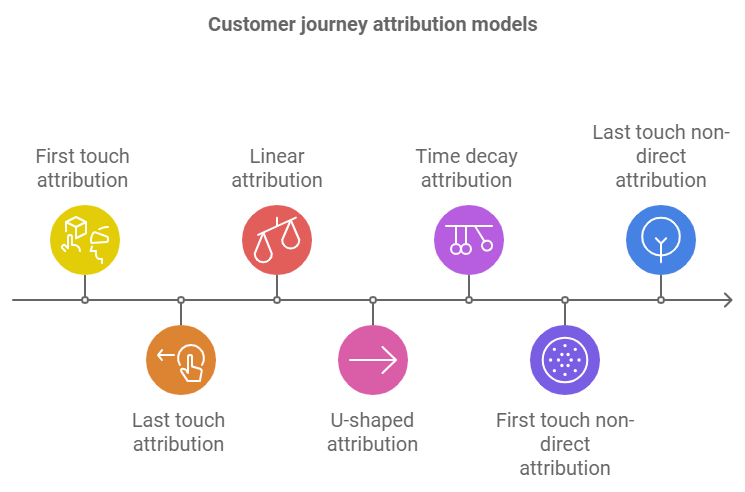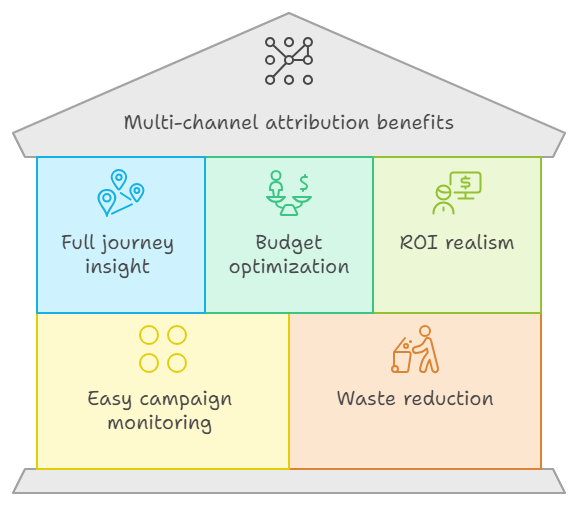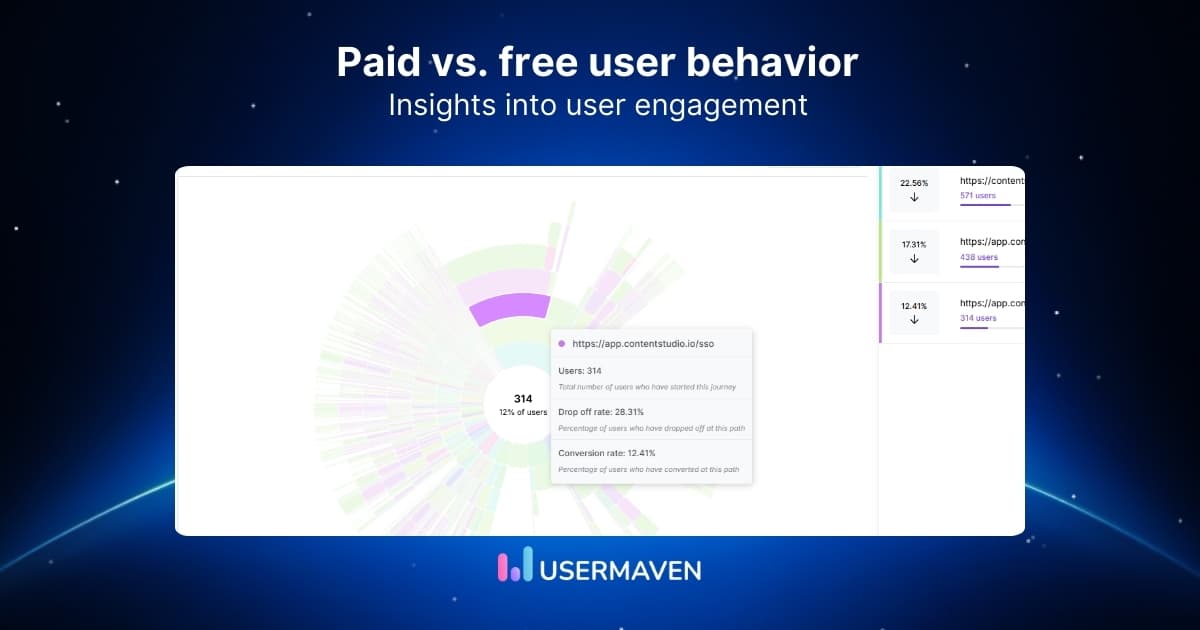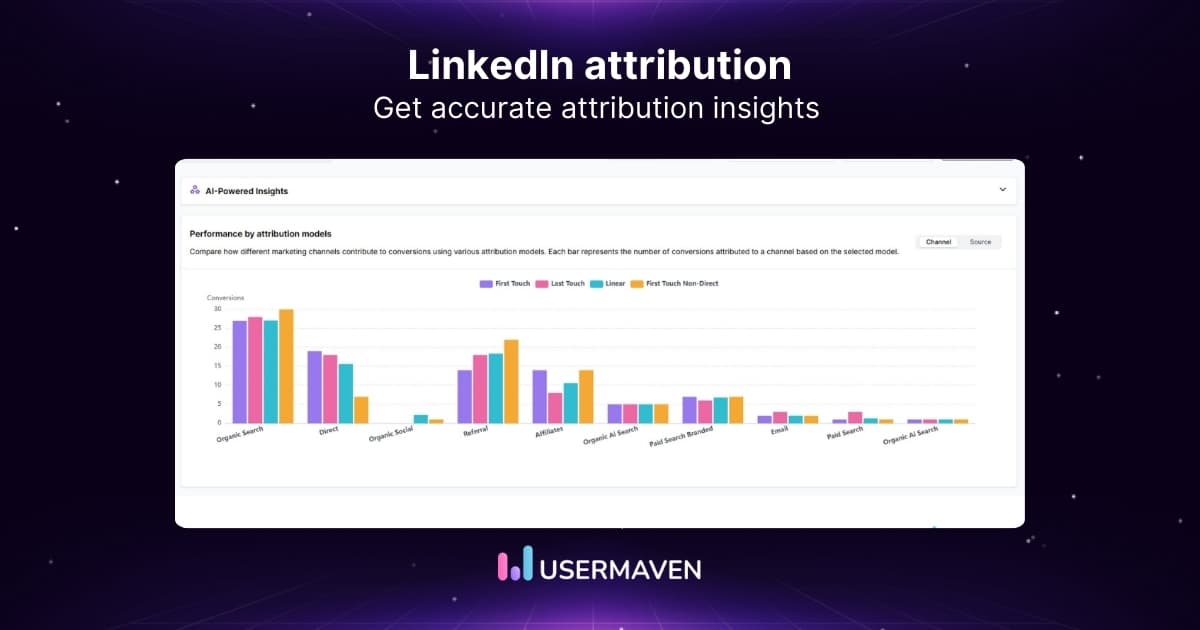What is multi-channel attribution and how it works?
Oct 18, 2025
6 mins read
Written by Ameena Hassan

Multi-channel attribution refers to assigning credit or value to each marketing touchpoint a customer interacts with before converting.
Understanding multi-channel attribution is essential for accurately measuring various marketing channels’ impact on conversions and their contribution to overall business success.
Traditional single-touch attribution models, such as last-click and first-click attribution models, only credit a single touchpoint for a conversion.
However, this approach needs to recognize the influence of other touchpoints that play a role in the customer journey.
Multi-channel attribution models, on the other hand, provide a more comprehensive view by considering all touchpoints. This approach helps identify the contribution of every touchpoint and campaign in conversion.
Let’s dive into the blog to understand the multi-channel attribution model better.
What is multi-channel attribution?
Multi-channel attribution is a marketing analytics methodology that helps businesses understand how multiple marketing channels and touchpoints contribute to customer conversions. Unlike traditional single-touch models that credit only one interaction (usually the first or last), multi-channel attribution considers the entire customer journey, from initial awareness to final purchase.
A real-world example
Let’s walk through a typical customer journey to illustrate the concept:
- Awareness: Sarah sees a Facebook ad for a new fitness app. She doesn’t click, but the brand name sticks in her mind.
- Interest: A week later, Sarah searches for “best fitness apps” on Google and sees the same app in the organic search results. She clicks and browses the website but doesn’t sign up.
- Consideration: The next day, Sarah receives a retargeting ad on Instagram showcasing the app’s features. She follows the brand’s Instagram account.
- Intent: A few days later, Sarah receives an email from the fitness app offering a free 7-day trial. She clicks the link but gets distracted before signing up.
- Evaluation: That weekend, Sarah saw a YouTube review of the app. Impressed, she decides to give it a try.
- Purchase: Sarah goes directly to the app’s website and signs up for the free trial, which later converts to a paid subscription.
In this scenario, which channel should get credit for Sarah’s conversion? The Facebook ad that created initial awareness? The Google search that led to the first website visit? The Instagram ad? The email? The YouTube review? Or the direct website visit where she finally converted?
This is where multi-channel attribution comes in. Instead of crediting just one touchpoint, it helps us understand the role each channel played in Sarah’s decision to subscribe.
Types of multi-channel attribution models
There are several types of attribution models, each offering a unique perspective on how different marketing channels contribute to conversions.

Usermaven’s seven attribution models
- First touch attribution
- What it does: Gives all credit to the first interaction in the customer journey.
- Best for: Understanding which channels are best at creating initial awareness.
- Example: If a customer first sees your brand on Facebook, then later buys after clicking a Google ad, Facebook gets full credit.
- Last touch attribution
- What it does: Gives all credit to the final touchpoint before a sale.
- Best for: Seeing which channels are best at closing sales.
- Example: If a customer interacts with many channels but buys after clicking an email, the email gets 100% credit.
- Linear attribution
- What it does: Shares credit equally across all touchpoints in the customer journey.
- Best for: Recognizing the value of all interactions in complex journeys.
- Example: If a customer interacts with your brand through five channels before buying, each channel gets 20% credit.
- U-shaped attribution
- What it does: Typically gives 40% credit to both the first and last interactions, with the remaining 20% spread among middle touchpoints.
- Best for: Highlighting the importance of both creating awareness and closing the sale.
- Example: In a journey with five touchpoints, the first and last each get 40% credit, while the middle three each get 6.67%.
- Time decay attribution
- What it does: Gives more credit to touchpoints closer to the sale.
- Best for: Businesses with longer sales cycles where recent interactions may matter more.
- Example: In a 30-day journey, a touchpoint on day 25 would get more credit than one on day 5.
- First touch non-direct attribution
- What it does: Gives credit to the first interaction, but ignores direct traffic.
- Best for: Understanding which marketing efforts first bring customers to your site, excluding direct visits.
- Example: If a customer first finds you through a Google search, then visits directly later, the Google search gets the credit.
- Last touch non-direct attribution
- What it does: Gives credit to the last interaction before a sale, but ignores direct traffic.
- Best for: Seeing which marketing efforts drive sales when customers often return directly to your site to buy.
- Example: If a customer clicks a paid ad, and then later types your URL to buy, the paid ad gets the credit.
Usermaven’s range of attribution models lets you look at your marketing performance from different angles. You can compare results across models to get a fuller picture of your customer journeys and see how effective your marketing channels are.
Usermaven’s diverse range of attribution models allows you to analyze your marketing performance from multiple angles. You can compare results across different models to gain a more comprehensive understanding of your customer journeys and the effectiveness of your marketing channels.
Implementing multi-channel attribution strategies
Implementing effective multi-channel attribution strategies is crucial for gaining accurate insights into the performance of marketing channels and optimizing their impact on conversions. Here are some critical steps to consider when implementing multi-channel attribution strategies:
1. Set clear goals
Define your conversion goals and key performance indicators (KPIs) that align with your business objectives. This will help you measure the success of your multi-channel attribution efforts.
2. Identify relevant touchpoints
Analyze and identify all potential touchpoints that customers interact with throughout their journey. This includes channels like organic search, paid search, social media, email marketing, and display advertising.
3. Choose the suitable attribution model
Test and evaluate different multi-channel attribution models and then select one that suits your business needs and aligns with your customers’ typical behavior.
4. Gather data and integrate systems
Collect data from various marketing channels and integrate them into a centralized analytics platform or customer relationship management (CRM) system. Ensure that data is accurate, consistent, and accessible for analysis.
5. Analyze and interpret data
Use Usermaven to analyze the data and gain insights into the contribution of each marketing channel. Look for patterns, trends, and correlations to understand how different touchpoints impact conversions.
6. Optimize marketing efforts
Make data-driven decisions to optimize marketing strategies based on your findings. Allocate budgets effectively, refine messaging, and adjust channel-specific tactics to maximize the impact of high-performing channels and improve underperforming ones.
7. Monitor and iterate
Continuously monitor and evaluate the performance of your multi-channel attribution strategies. Adapt and refine your approach based on evolving customer behavior, market trends, and emerging channels.
By implementing multi-channel attribution strategies, businesses can gain a holistic understanding of the customer journey, allocate resources effectively, and optimize marketing efforts for better conversions and overall business growth.
Benefits of multi-channel attribution
In the world of digital marketing, knowing where your efforts are paying off is super important. That’s where multi-channel attribution comes in. Let’s talk about why it’s fantastic and how it can make a big difference in how you do your marketing.

1. Seeing the whole journey
Okay, so when people buy stuff, they usually check out many different places online first. Multi-channel attribution helps you understand this journey. It’s like having a map that shows you every step a customer takes, from discovering your product to hitting that “buy” button.
2. Smarter budget decisions
Imagine if you had a way to spend your marketing budget where it matters most. Multi-channel attribution does just that. It helps you figure out which places and times your marketing money works best. So, you can put more cash into the stuff that’s bringing in the most sales.
3. Getting real about ROI
Do you want to know if your marketing is making you money? Of course! Multi-channel attribution lets you do just that. It helps you see exactly how much cash each marketing channel is bringing in. No more guessing – you’ll know what’s working and what’s not.
4. Campaign monitoring made easy
We all want our marketing campaigns to be remarkable. With multi-channel attribution, you can see which parts of your campaigns are hitting the bullseye and which need a little work. It’s like having a GPS for your marketing strategy.
5. Bye-bye, wasted money
Nobody likes wasting money. Multi-channel attribution helps you find out if you’re spending money on marketing channels that are doing little for you. When you know where to cut back, you can save some cash.
6. Getting to know your customers better
Understanding your customers is gold. Multi-channel attribution shows you how your customers are interacting with your brand online. This info helps you create super-targeted marketing that speaks to their needs.
7. Making smart choices with data
In today’s world, data is king. Multi-channel attribution is all about data and facts. With this attribution, you’ll make decisions based on real info, not just guesswork.
8. Beating the competition
Staying ahead of the competition is a big deal. If you use multi-channel attribution and they don’t, you’ve got an advantage. You can outsmart them by knowing what’s really working in your marketing.
9. Growing steadily
We all want our businesses to grow. Multi-channel attribution helps you do just that. When you use it to fine-tune your marketing, you’ll see more sales and profits over time.
Related: How to use conversion analysis for business growth
Using multi-channel attribution with Usermaven
Understanding how your marketing efforts work together is key in today’s digital world. Usermaven, a new and powerful analytics tool, helps businesses do just that. It offers a range of features to help you see how your marketing channels work together to bring in customers.
Main attribution features in Usermaven
1. Seven attribution models: Usermaven lets you choose from seven ready-made models that fit your business needs. This allows you to explore different ways of analyzing your data to determine what works best for you.

2. Lookback window: You can specify how far back you want to look at your data, ranging from 30 to 180 days before conversion. This helps you see all the important touchpoints without getting bogged down in old data. A shop selling cheap items might look back 30 days, while a luxury travel company might look back 180 days.
3. Days to convert analysis: Usermaven tracks how long it takes for customers to convert after their first interaction. This helps you understand your sales cycle length and how different channels impact conversion speed. For instance, you might find that customers who first interact through a blog post take longer to convert but have a higher lifetime value.

4. Conversion path visualization: See the exact path customers take before converting. This feature shows you the sequence of touchpoints that lead to a sale, helping you identify common patterns and optimize your marketing funnel. You might discover that customers who interact with your brand on at least three different channels before converting tend to have a 50% higher purchase value.

5. Detailed content/channel analysis: See how each of your marketing channels performs at different stages of the customer journey. This helps you understand which channels are good for making people aware of your brand, which are best for nurturing leads, and which are best for final sales. You might find out that your podcast ads are great for initial awareness, your blog posts are good for engagement, and your emails are best for final sales.

6. AI-driven recommendations: Usermaven’s AI analyzes your data across all attribution models and provides actionable recommendations. It can quickly spot unusual patterns in your data, alerting you to potential issues or opportunities that you might otherwise miss.

7. Custom channel mapping: Create your own groups of marketing channels for more precise analysis. This lets you tailor your analysis to match your specific marketing efforts. Instead of putting all social media in one group, you could have separate groups for organic social posts, paid ads, and influencer partnerships.
With Usermaven, you’re not just tracking sales – you’re gaining insights that can improve your marketing strategy and boost your profits.
Conclusion
In conclusion, understanding multi-channel attribution is crucial for businesses to measure the impact of various marketing channels on their success. It helps assign value to different parts of the customer journey, which is important for making smart marketing decisions.
There are different attribution models to choose from, but the key is setting goals, tracking touchpoints, and analyzing data to optimize your marketing strategies. Doing this can save money, understand your customers better, and grow your business. Tools like Usermaven can make this process easier by tracking customer interactions and providing helpful insights.
Sign up today for Usermaven to improve your marketing efforts!
Maximize your ROI
with accurate attribution
*No credit card required
FAQs
How does multi-channel attribution differ from single-touch attribution?
Single-touch attribution credits only one interaction, while multi-channel attribution considers all touchpoints in the customer journey.
What are some common attribution models?
Popular models include first touch, last touch, linear, U-shaped, and time decay.
How do I choose the right attribution model?
Select based on your business goals and customer behavior. Testing different models can help determine the best fit.
What is the benefit of using multi-channel attribution?
It helps in smarter budgeting, understanding customer journeys, and improving marketing ROI.
How can Usermaven help with multi-channel attribution?
Usermaven offers seven attribution models, AI-driven insights, and detailed conversion path analysis to optimize marketing performance.
Try for free
Grow your business faster with:
- AI-powered analytics & attribution
- No-code event tracking
- Privacy-friendly setup


